There are many reasons why you would want to go trail running with poles. In some parts of the word, using trekking poles (also known as hiking poles) for trail running is very common, whereas in other places where steep mountain trails are less common, seeing someone running with poles is more unusual.
In this post we cover the pros and cons of using poles for trail running, how and when to use poles, and when NOT to use poles. We also share our recommendations for where to buy suitable lightweight, folding poles for trail running.
5 Benefits of Trail Running with Poles
Let’s start with the benefits of trail running with poles and why you would want to use them.
1. Uphill ascending on steep mountain trails
Running with hiking poles can help you make light work of uphill climbs on steep and often mountainous routes.
In my opinion, the benefit when it comes to supporting your uphill ascent on mountain trails is the biggest advantage in having them. It’s like climbing uphill with four-wheel-drive, as planting them in front of you provides balance and guidance – I can definitely climb steeps a lot more quickly with, than without these running sticks.
2. Using poles for trail running saves your legs on long races with a lot of climbing and decent
If you’re using trail running poles and your arms/back/shoulders to help you up and downhill when it gets tough, then your legs (especially your quads) will be fresher for longer than if you hadn’t used running poles.
This can make a huge difference over longer runs and races where you may be out running an ultramarathon for 8+ hours. Believe it or not, the biggest difference poles can make is actually on saving your legs on the decending, more so than ascending.
3. Using poles can help maintain a sustainable running rhythm
Trekking poles definitely help me more easily find a sustainable pacing and step rhythm that I can maintain for long stretches. You can use them almost like a metronome to help keep you on a certain cadence and pace – it’s almost meditative.
4. Using poles when running can help probe and balance on steep descents
Using hiking poles can help you navigate large, steep steps down, particularly when the terrain looks (or is) slippery or made of loose rock.
You do need to be mindful, however, that poles can be a hindrance on many other downhill sections where the terrain isn’t as steep, as they can get caught or you may even trip over them yourself, so I put them away or carry them when the gradient levels off from the very steep terrain.
5. Space (and self) preservation on busy European trail races
In races where everyone has hiking poles out from the very start, having your own trail running poles help ensure someone doesn’t side-step or place their pole into the space immediately in front of you (stopping you in your tracks, unless you trip over them instead).
They are also handy for batting off wayward poles that can get waved or slip towards you in a crowd. This was invaluable at races such as the last time I started the Lavaredo Ultra Trail and spent the first 45 minutes in a tightly-packed crowd and had to avoid losing an eye!
It’s worth noting that while this is annoying, most people are probably completely oblivious to the nuisance and hazard they pose, so it’s not productive to let it wind you up – just be prepared!
RELATED READING: 5 Best Trail Running Poles: For Ultrarunning & Hiking
4 Disadvantages to Trail Running with Poles
1. Trail running poles are an extra piece of gear to take with you and carry
In terms of things to remember, store and additional weight, poles mean two more relatively large pieces of gear.
Carrying poles also makes doing other things (like eating) more tricky when on-the-move.
2. You won’t want to use them all the time
When I run with poles I usually use them mostly on the steep climbs and some of the steeper descents, especially later in a long run or race when my legs are more tired.
So at the times you aren’t using your poles, you have to either carry them or pack them away when not using them. Having a hydration pack that can quickly stow your poles is therefore important.
3. If you train with poles, then you may not want to race without them
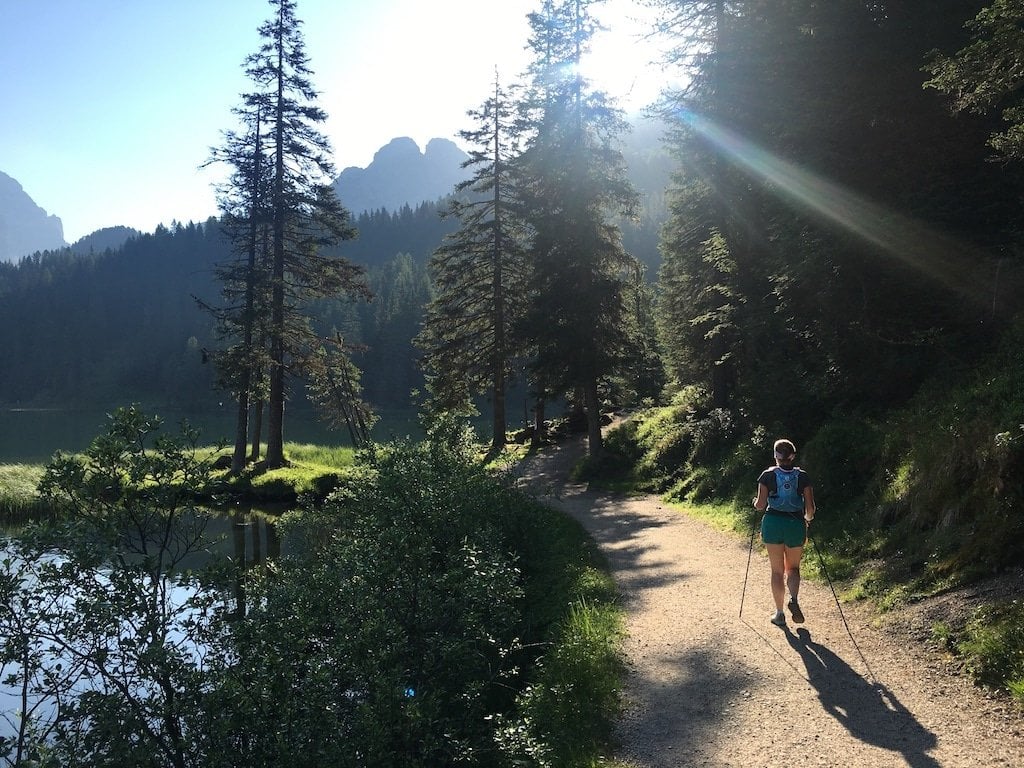
There’s a risk of running poles becoming like crutches that you get dependent on, if you find you need them all the time for any hilly runs.
Generally, a dependency on a piece of gear is something we want to minimize and limit to truly key pieces of gear such as your trail running shoes. Imagine if you felt you NEEDED them, and then you lose or break one/both? Gah!
4. Hiking poles are not permitted on some trail running races
It’s worth checking your race rules. But generally, if it’s a mountainous race of 30k+, particularly in Europe, then you’ll be in the minority without them.
Tips for using hiking poles trail running
- Buy the lightest running poles you can afford. This helps not just with your pack weight, but your arms when in use.
- Folding/collapsible poles will save you space when stowed in your race vest (or carried)
- Carry them both in one hand when not in use, with the pointy end facing forwards. This way you are less likely to catch it on your feet or swing the sharp end back into someone else
- Be careful how you use and hold them – if you hit or trip someone else (or yourself – eminently possible) then it could cause a very nasty injury. It’s also very annoying when someone actually, or very nearly does this to you
- Watch where you plant them in front of you – pick a firm-looking spot that isn’t wedged between two rocks/roots (as this could result in breaking the pole if it gets stuck on its way out) and is far from your (and other peoples) feet
- Alternate or simultaneous pole-ing? I find that sometimes it helps to plant both poles together out in front, to help me up steep sections with speed. Otherwise, I prefer placing them alternately.
Best hiking poles for trail running
There are many brands out there now offering trail running (or lightweight hiking) poles, particularly around Europe where they are very popular. We are also seeing an increase in popularity of mountain and technical running in America, and so I expect more people will be needing to get their hands on hiking poles for trail running in the US.
These carbon Z Black Diamond poles are perfect for trail running and long days in the mountains, as they are folding, have a good hand-grip and fold down small.
Find the Best Price for Black Diamond Distance Carbon Z running poles
|
|
$169.95
out of stock
|
See Deal |
|
|
$93.47
out of stock
|
See Deal |
|
|
$84.93
out of stock
|
See Deal |
|
|
See Deal |
To head over to our trail running poles buyers guide, which includes our current top pole recommendations and details on where to buy them online, click here: Trail Running Poles Buyer’s Guide.
Do you run with or without poles for your hilly/mountain runs? Which poles do you use and why? Share all in the comments section below, we’d love to hear your thoughts 🙂
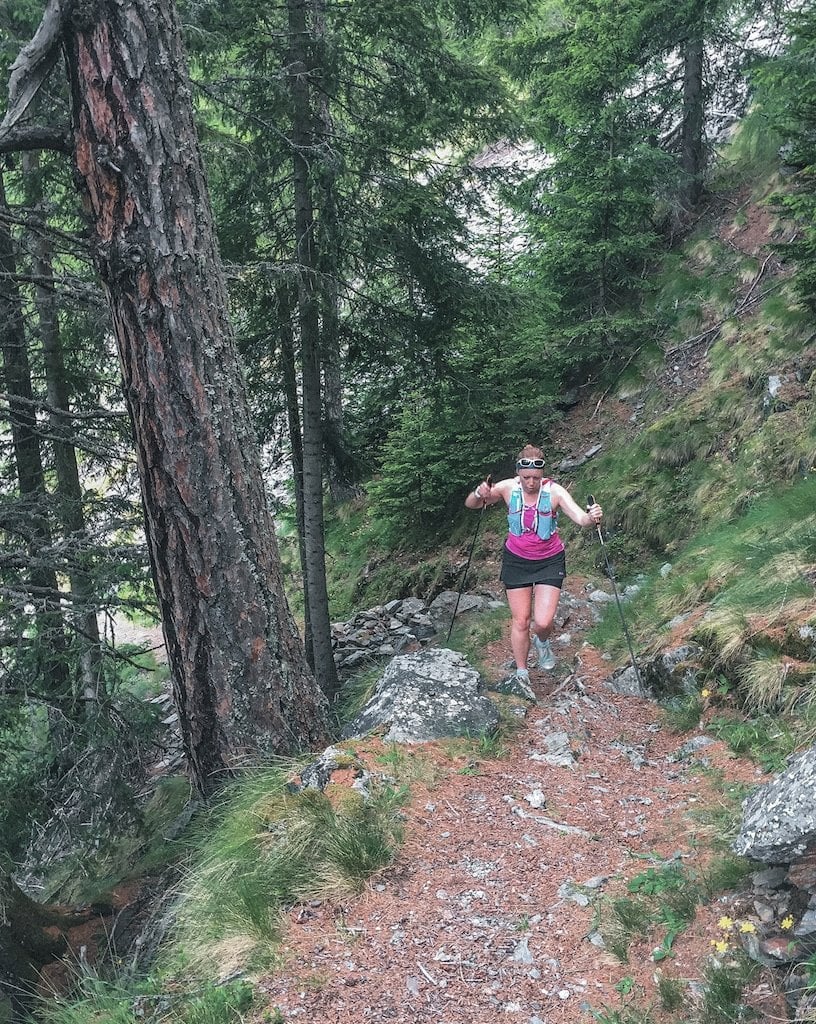
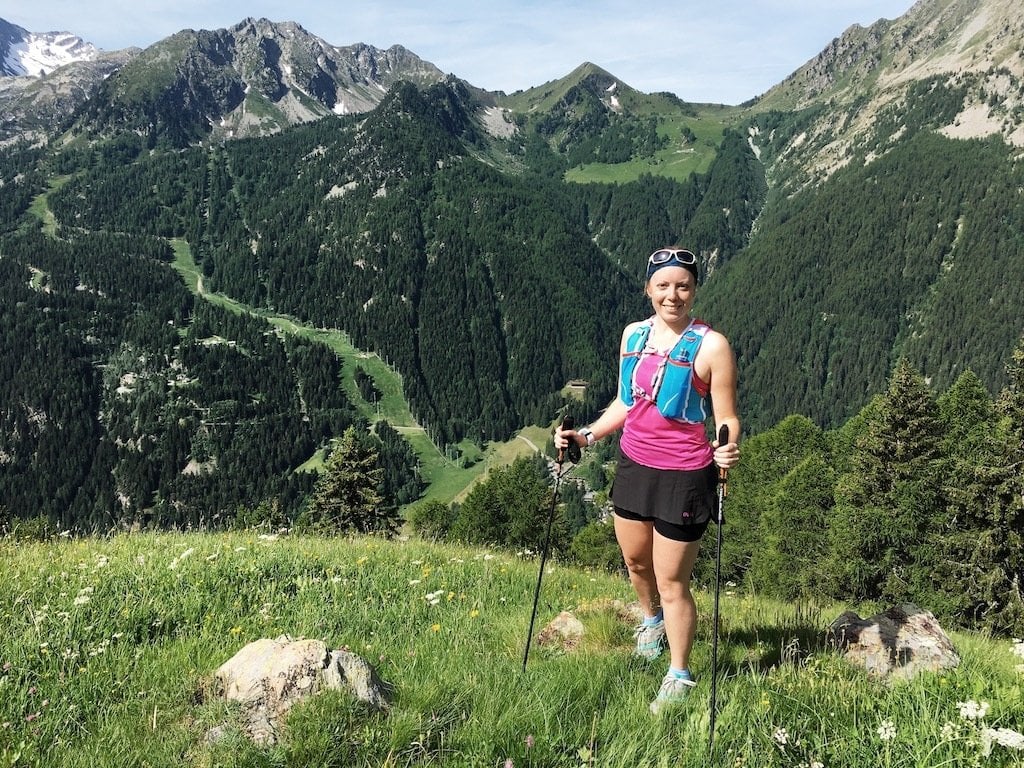




![The Best Trail Running Shoes [2024] The Best Trail Running Shoes [2024]](https://www.trailandkale.com/wp-content/uploads/2024/02/best-trail-running-shoes-Trail-and-Kale-Recommends-2024-110x75.webp)

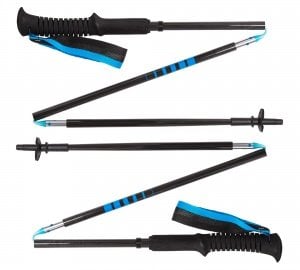
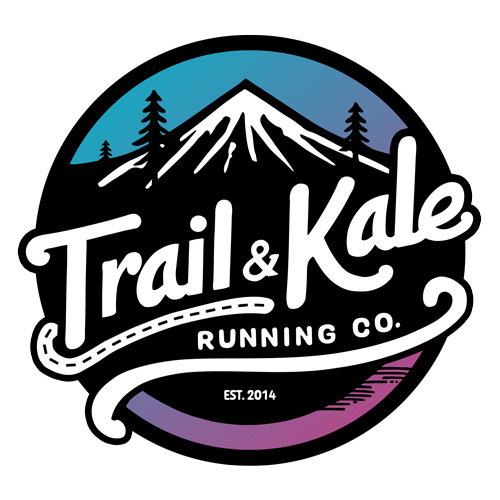
How do you store the poles on the salomon race vest? There are pole holders in the back but the black diamond poles fold “too” small to use the pole holders.
Hi Davy, the Salomon race vests are only really designed to store the longer folding poles, in a diagonal from one shoulder across the back to the opposite waist. I improvise and when using the Salomon race vests by adding a bungee cord (such as an elastic shoe lace) and toggle to the back of the pack, so it looks like an Ultimate Direction vest (which come with a bungee on the back). Then the poles can be tucked down these when folded, with the ends fitting in the main elastic stuff-pocket that runs across the back of the pack. Not ideal but it works, especially when the pack is at least partially full, to hold the poles in place.
I hope this helps! I recently posted a review of an Ultimate Direction vest which shows pictures of the bungee cord I’m referring to.
Check out this (german) blog post – it shows how all the top runners at last UTMB carried their poles.
Salomon sells a “quiver” add-on for about $20 that is great.
Hi Bruce, thanks for sharing the article, it’s great to see the different ways the pros are carrying them in their race vests. My personal favourite so far is the UD style on the front, you don’t even know they’re there once stowed.